A liquid of density 1000kg/m3 is flowing in streamline motion through a tube of non-uniform cross section. The tube of Inclined with the ground [Fig. 3.17] The area of cross sections at points P and Q or the tube are 5×10−3m2and10×10−3m2
respectively. The height of the points P and Q from the ground are 3 m and 6 m respectively. The velocity of the liquid at point P is 1 m/s. Calculate the work done per unit volume due to (i) the pressure and (ii) gravitational force for the flow of liquid from point P to point Q .
![A liquid of density 1000 kg//m^3 is flowing in streamline motion through a tube of non-uniform cross section. The tube of Inclined with the ground [Fig. 3.17] The area of cross sections at points P and Q or the tube are 5xx10^-3m^2 and 10xx10^-3 m^2 respectively. The height of the points P and Q from the ground are 3 m and 6 m respectively. The velocity of the liquid at point P is 1 m/s. Calculate the work done per unit volume due to (i) the pressure and (ii) gravitational force for the flow of liquid from point P to point Q .](https://d10lpgp6xz60nq.cloudfront.net/physics_images/CHY_DMB_PHY_XI_P2_U07_C03_SLV_010_Q01.png)
From equation of continuity,
A1v1=A2v2
or, v2=(A1A2)v1=(5×10−310×10−3).(1)=12m/s.
Applying Bernoulli.s theorem we get,
p1+12ρv21+ρgh1=ρ2+12pv22+ρgh2
or, ρ1−ρ2=ρg(h2−h1)+12ρ(v22−v21) .....(1)
(i) Work done per unit volume per unit volume of the liquid due to the pressure of the streamline flow from P to Q is,
Wp−p1−p2
Wp=ρg(h2−h1)+12ρ(v22−v21) [ from equation (1)]
=[(1000)(9.8)(6−3)+12(1000)(14−1)]
=[3×9.8−38]×103=29025J/m3
(ii) Work done due to gravitational force for the streamline motion from P to Q is,
Wg=ρg(h1−h2)=1000×9.8×(3−6)
=−29400J/m3.
Topper's Solved these Questions
- VISCOSITY AND SURFACE TENSIONBOOK - CHHAYA PUBLICATIONCHAPTER - VISCOSITY AND SURFACE TENSIONEXERCISE - EXERCISE (HIGHER ORDER THINKING SKILL (HOTS) QUESTIONS
26 Videos
- VISCOSITY AND SURFACE TENSIONBOOK - CHHAYA PUBLICATIONCHAPTER - VISCOSITY AND SURFACE TENSIONEXERCISE - MCQs
22 Videos
- VECTORBOOK - CHHAYA PUBLICATIONCHAPTER - VECTOREXERCISE - CBSE SCANNER
19 Videos
- WBCHSE QUESTION PAPER -2019BOOK - CHHAYA PUBLICATIONCHAPTER - WBCHSE QUESTION PAPER -2019EXERCISE - SECTION - II ( GROUP -D)
10 Videos
Similar Questions
A non-viscous liquid of constant density 1000kg/m3 flows in a streamline motion along a tube of variable cross section. The tube is kept inclined in the vertical plane as shown in Figure. The area of cross section of the tube two point P and Q at heights of 2 metres and 5 metres are respectively 4×10−3m2 and 8×10−3m2. The velocity of the liquid at point P is 1m/s. Find the work done per unit volume by the pressure and the gravity forces as the fluid flows from point P to Q.
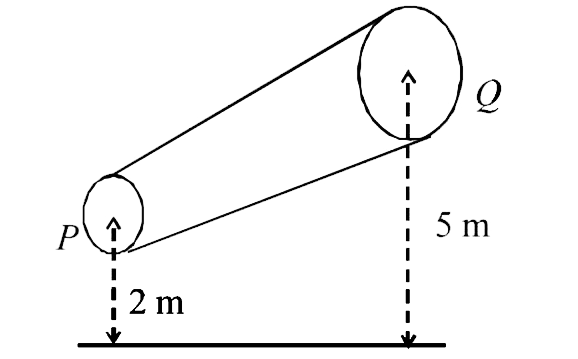
View SolutionA non-viscous liquid of constant density 1000kg/m3 flows in a streamline motion along a tube of variable cross section. The tube is kept inclined in the vertical plane as shown in Figure. The area of cross section of the tube two point P and Q at heights of 2 metres and 5 metres are respectively 4×10−3m2 and 8×10−3m2. The velocity of the liquid at point P is 1m/s. Find the work done per unit volume by the pressure and the gravity forces as the fluid flows from point P to Q.

View Solution
Knowledge Check
A non-viscous fluid of constant density of 1000kg/m3 flows in stream line motion along a tube of variable cross-section
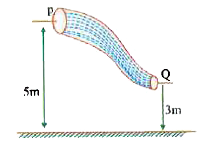 The area of cross-section at two P and Q at lengths 5m are 40cm2and20cm2 respectively. If velocity of fluid at P is 3m/s then find velocity of fluid at Q.A3m/sB4m/sC5m/sD6m/s
The area of cross-section at two P and Q at lengths 5m are 40cm2and20cm2 respectively. If velocity of fluid at P is 3m/s then find velocity of fluid at Q.A3m/sB4m/sC5m/sD6m/sTwo metal spheres are falling through a liquid of density 2×103kg/m3 with the same uniform speed. The material density of sphere 1 and sphere 2 are 8×103kg/m3 and 11×103kg/m3 respectively. The ratio of their radii is :-
A118B√118C32D√32A horizontal tube of non uniform cross section has radii fo 0.1 m and 0.05 m respectively at M and N,
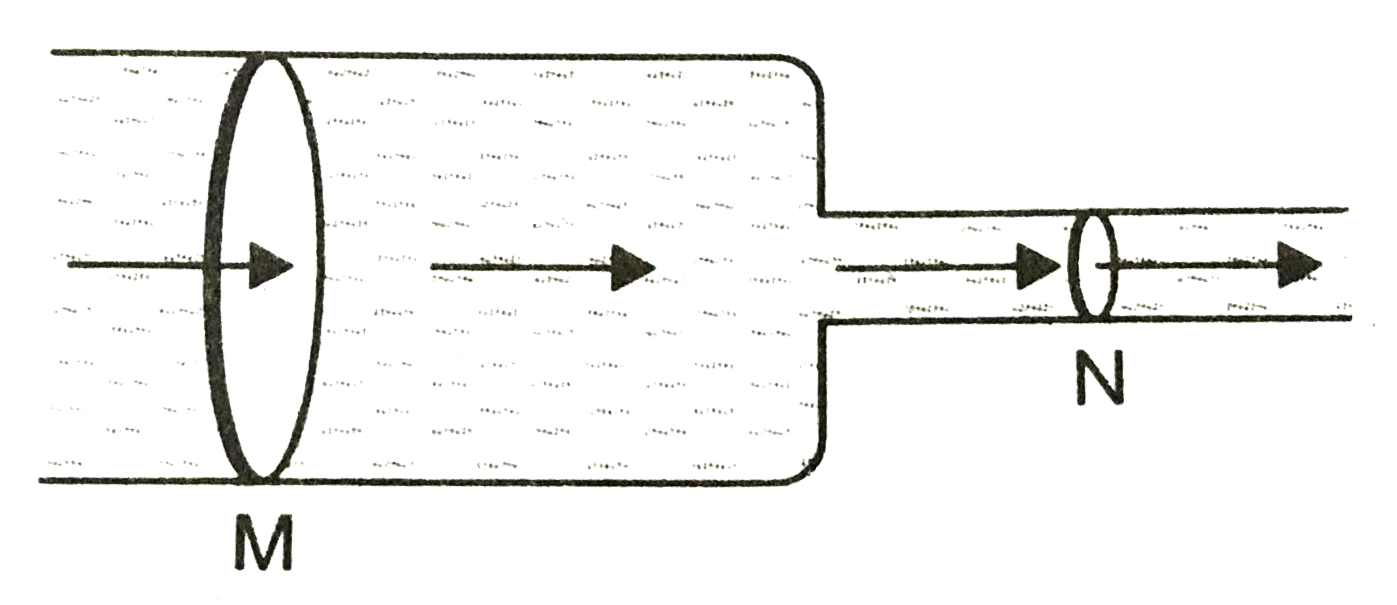
For a streamline flow of liquid the rate of liquid flow isAcontinuously changes with timeBgreater at M then at NCgreater at N then at MDsame at M and N
(i) Air (density=ρ) flows through a horizontal venturi tube that discharges to the atmosphere. The area of cross section of the tube is A1 and at the constriction it is A2. The constriction is connected to a water (density=ρ0) tank through a vertical pipe of lenght H. Find the volume flow rate (Q) of the air through tube that is needed to just draw the water into the tube.
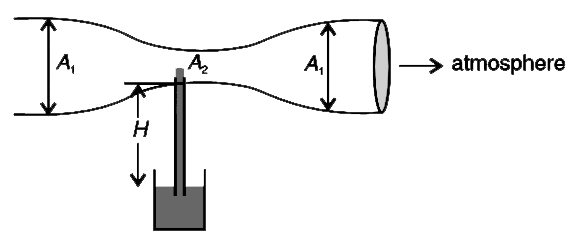
(ii) A non viscous liquid of constant density ρ flows in a stremline motion along a tube of variable cross section. The tube is kept inclined in the vertical plane as shown in the figure. The area of cross section of the tube at two points P and Q at heights of h1 and h2 are respectively A1 and A2. The velocity of the liquid at point P is v. Find the work done on a small volume ΔV of fluid by the neighbouring fluid as the small volume moves from P to Q.
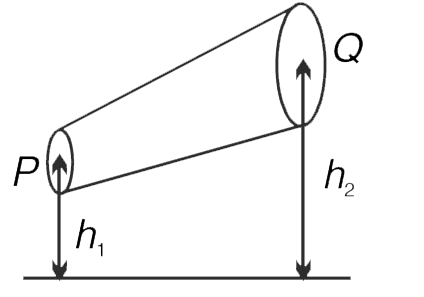
View SolutionA non-viscous liquid of constant density 500kg/m3 flows in a variable cross-sectional tube. The area of cross section of the tube at two points P and Q at heights of 3m and 6m are 2×10−3m3 and 4×10−3m3, respectively. Find the work done per unit volume by the forces of gravity as the fluid flows from point P to Q.

View SolutionA non-viscous liquid of constant density 500kg/m3 flows in a variable cross-sectional tube. The area of cross section of the tube at two points P and Q at heights of 3m and 6m are 2×10−3m3 and 4×10−3m3, respectively. Find the work done per unit volume by the forces of gravity as the fluid flows from point P to Q.

View SolutionTwo metal spheres are falling through a liquid of density 2×103kg/m3 with the same uniform speed. The material density of sphere 1 and sphere 2 are 8×103kg/m3 and 11×103kg/m3 respectively. The ratio of their radii is :-
View SolutionA non viscous liquid of constant density 103kg/m3 flows in stream line motion along a vertical tube PQ of variable cross-section. Height of P and Q are 2m and 2.5m respectively. Area of tube at Q is equal to 3 times the area of tube at 'P'. Then work done per unit volume by pressure as liquid flows from P and Q. Speed of liquid at 'P' is 3m/s.
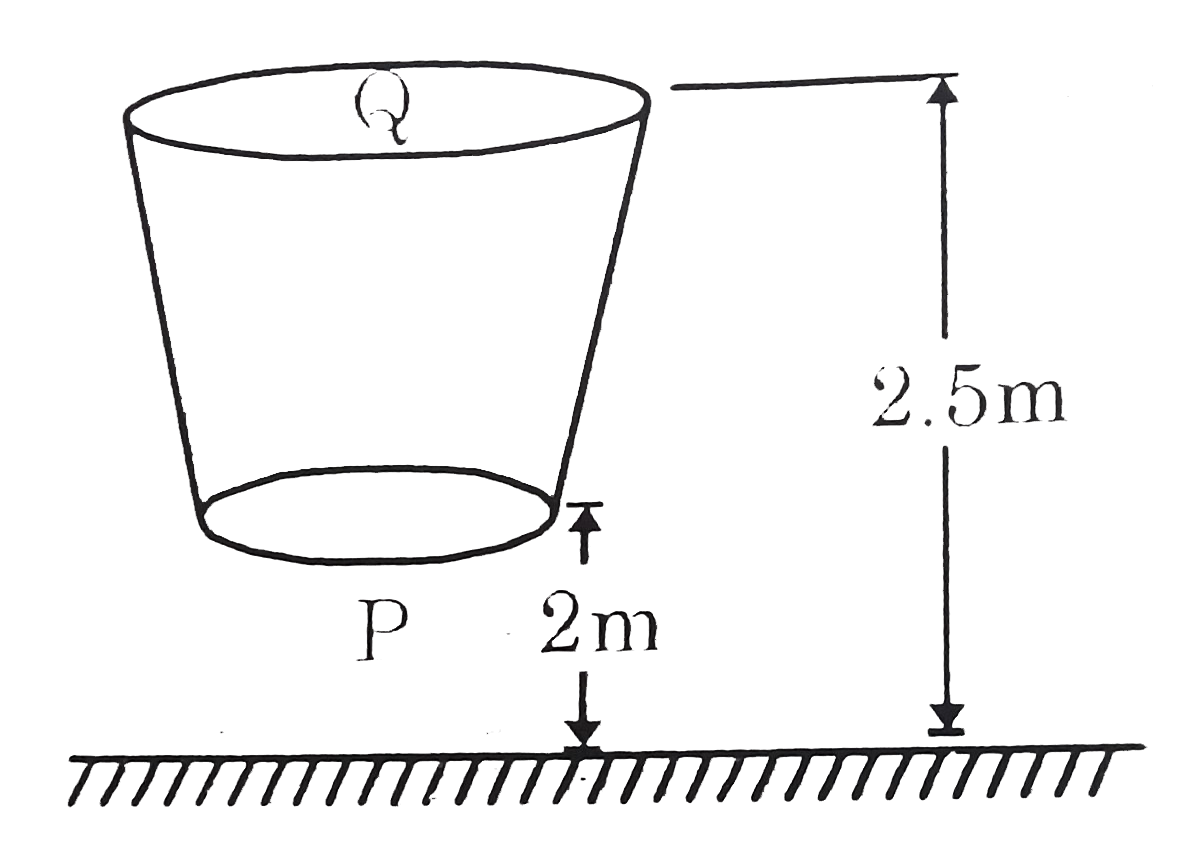
View Solution
